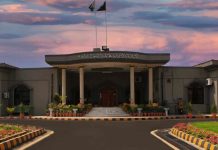ISLAMABAD: ML-1 will transform Pakistan’s railway infrastructure in a major way, WealthPK reported on Tuesday.
The China-Pakistan Economic Corridor (CPEC) is the pathway for Pakistan to achieve the goals of prosperity and development.
A number of projects in the transportation and energy sectors have either been completed or in various stages of completion under CPEC.
ML-I or Main Line 1 is the most significant one to revamp the major railway tracks in the country with a view to reviving the sagging railways infrastructure and putting it back on track to achieve its past glory.
Under the project, the railway track between Karachi and Peshawar and up to Havelian will be upgraded and dualised. Trains with speeds of around 120 to 160 kilometres per hour would run on the track. Currently, the trains can move at speeds from 65km to 105km per hour, WealthPK reported.
ML-1, which has been declared strategic, will overhaul over 1,733 kilometres of track, and will serve to improve trade not only between Pakistan and China, but also among the regional states.
The goal of this project, under which rehabilitation and construction of major bridges will be carried out, is to sharply improve the country’s transportation system.
The $6.8 billion project, whose PC-I was approved by the Executive Committee of the National Economic Council on August 5, 2020, will be executed by financing through the Chinese Government Concessional Loan.
According to experts, the ML-1 is a ‘game changer’, and once completed, Peshawar and Karachi will become the centres of business activity and a source of livelihood for tens of thousands of people. The project is estimated to create job opportunities for 24,000 people.
The project, which will see level crossings converted into underpasses and flyovers, will also benefit the landlocked Central Asian countries through land route linkages.
The ML-1 project also includes the construction of a dry port in Havelian tehsil of the Haripur district of Khyber Pakhtunkhwa, which is expected to be completed before the Peshawar-Karachi train line overhaul. The dry port will help promote trade, safe storage and handling of goods containers.
As this project has such a massive potential for creating job opportunities, it will attract people from rural areas, resulting in rural-urban migration and urbanisation. Rural-urban migration will alleviate unemployment in the agriculture sector and increase productivity, WealthPK reported.
According to the Lewis model of economic development, rural-urban migration is a key factor in the process of economic development and provides a foundation for industrialisation.
Under the ML-1, which is one of the biggest projects in Pakistan in terms of finance, the whole length of the track will be fenced. The ML-1 track passes through some of Pakistan’s most densely-populated areas, including Hyderabad, Nawabshah and Rohri districts in the Sindh province, Rahimyar Khan, Bahawalpur, Khanewal, Sahiwal, Lahore, Gujranwala and Rawalpindi districts in the Punjab province and areas from Peshawar to Haripur and onwards in the Khyber Pakhtunkhwa province.
These regions stand to greatly benefit from this mega project, whose framework agreement and commercial contract for preliminary design was signed in May 2017.
It is clear that the project’s benefits will not be limited to a single region or location and they will be felt throughout Pakistan.
Without the development and transformation of the railways, Pakistan’s economy will not be able to pick up the pace. And the ML-1 is going to provide that pace. – INP





